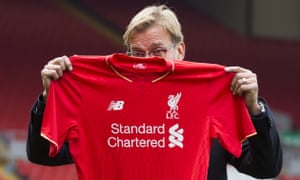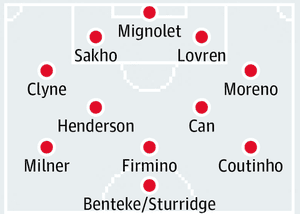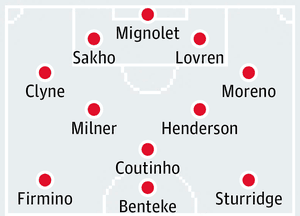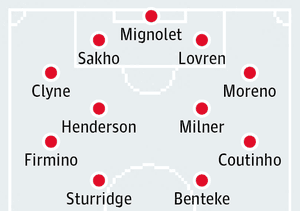The German might not implement his entire Borussia Dortmund philosophy at Anfield but the squad he has to work with appears well equipped
The most obvious conclusion when assembling a Jürgen Klopp-style 4-2-3-1 from Liverpool’s existing first-team players is that the side looks surprisingly exciting. The malaise at Anfield in the final months of Brendan Rodgers’ reign has tricked many into thinking this is not a talented group of players, and you wonder how a simple breath of fresh air might sparkLiverpool into life.
Klopp will provide far more than that, of course, and it is impossible not to wonder how the German coach will transfer his Borussia Dortmund philosophy to his new players. Working out precisely what his philosophy constitutes, however, is trickier than you might expect.
Klopp was in charge of Dortmund for seven years and inevitably his side progressed significantly during that period, evolving when increased funds became available to strengthen his side, and also when Dortmund were no longer able to approach games with an underdog mentality. The side that won the Bundesliga in 2010-11 and 2011-12 was significantly more functional than the teams Klopp assembled in his final three years, and it is worth remembering that Klopp won the league before Marco Reus and Ilkay Gundogan had joined, and before Robert Lewandowski had become a regular.
Although heavy pressing became a key part of Klopp’s philosophy, this was generally what the Germans term gegenpressing – recovering the ball immediately after possession has been lost – rather than pressing relentlessly for the entire game, as you may expect of a Marcelo Bielsa side. Also, it is worth remembering that the earlier Dortmund sides depended less on the concept of winning the ball in advanced positions, and instead excelled at attacking transitions, constructing lightning-quick counterattacks to sprint from the edge of their own area to the opposition box.
Liverpool look fairly well-suited to Klopp’s philosophy. In defence, Nathaniel Clyne and Alberto Moreno are quick, technical and attack-minded full-backs, although the latter will certainly require work on the defensive side of his game. At Dortmund, the full-backs tended to attack in bursts rather than with constantly high positioning, and that should suit both players.
The defence has constantly troubled Liverpool in recent years, but collective failings are not necessarily a sign of individual inadequacy, and both Mamadou Sakho and Dejan Lovren looked perfectly composed before heading to Anfield. Lovren was particularly good at Southampton in a high defensive line and in a side that pressed excellently as a unit. He might benefit more than anyone from a change of coach. Joe Gomez would be more suited to a centre-back role than left-back under Klopp.
In the two deep-lying midfield slots, Klopp liked a particular type of player – mobile, energetic footballers who were composed in possession but capable of sliding forward past opposition pressure and into attacking zones.Sven Bender, Ilkay Gundogan and Nuri Sahin were technical box-to-box midfielders rather than old-school destroyers or gifted deep-lying playmakers, and Klopp will appreciate already having players in this mould to depend on. Jordan Henderson is not dissimilar from Gundogan, while James Milner could be coached into a suitable partner, even if their combination did not look particularly stable under Rodgers. Emre Can is another potential solution and might play in midfield rather than at the back.
Out wide is where Klopp’s side changed most as Dortmund went from surprise title winners to a Champions League favourite. Initially he depended on Jakub Blaszczykowski and Kevin Grosskreutz – two unspectacular, hard-working, up-and-down wide midfielders – although gradually he brought through Mario Götze, who often played on the right, and recruited Marco Reus for the left.
Roberto Firmino and Coutinho could be options, although Klopp might prefer to use one of those as his No10, with a player in the mould of Milner or Henderson providing energy on the other flank. Coutinho would be the most obvious Shinji Kagawa-esque No10, but Firmino is a more dynamic player and, having spent four years with Hoffenheim, might understand Klopp’s German methods better.
The big question is how to accommodate Christian Benteke and Daniel Sturridge. A switch to a 4-2-1-3, often his Plan B with Dortmund, would allow Sturridge to play high up on the flank, but he would not like a wide role in the 4-2-3-1, which involves lots of defensive work, and Klopp has rarely played with two centre-forwards. It might be a choice between them, and both would have to do much more without possession than they are accustomed to.
A more exciting alternative would be, a 4-4-2 in the style Diego Simeone plays at Atlético Madrid. Both forwards would need to drop deep without the ball and the work rate of the team would need to be exceptional. But if Klopp imposes a compact style on the side quickly, this could work.
There would be losers. Lucas Leiva is probably not mobile enough to play a heavy pressing game, Joe Allen would need to move the ball quicker and Martin Skrtel might struggle with a high defensive line.
However, Klopp might surprise us. Pep Guardiola has not implemented tiki-taka at Bayern, and both Carlo Ancelotti and José Mourinho have changed their approach more than anticipated when moving to a new country. A noted admirer of the Premier League’s virtues, Klopp might shed his Dortmund philosophy more than we expect.

















Post a Comment